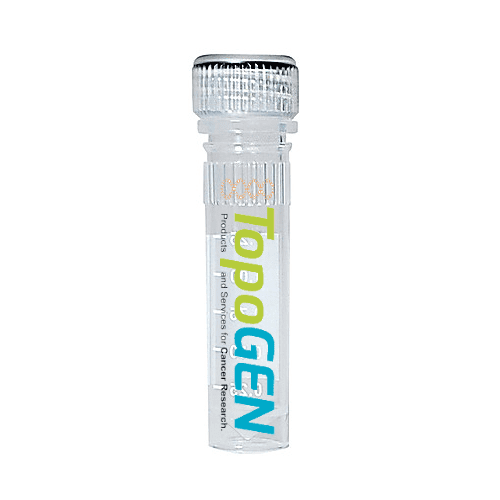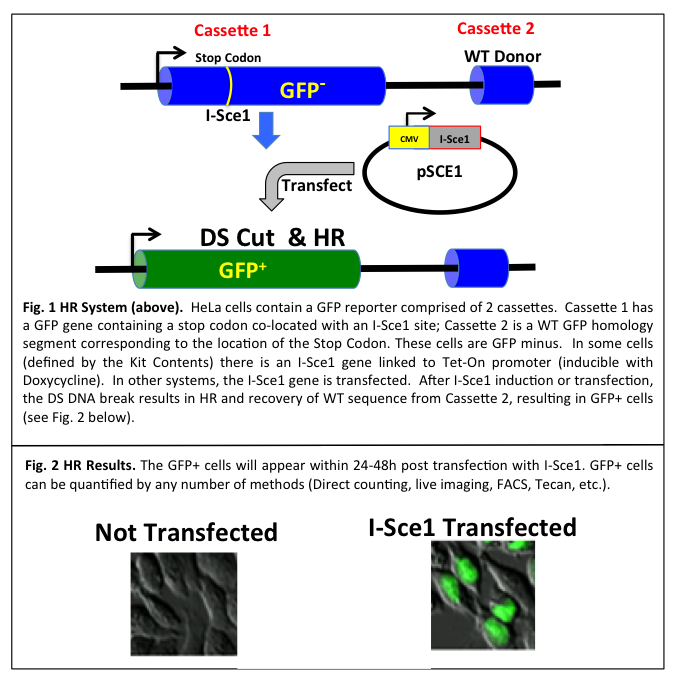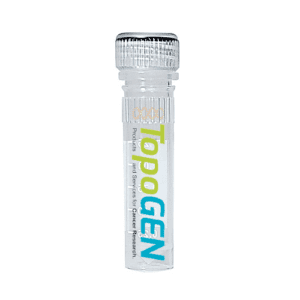Academic pricing is shown. For-profit institutions should contact TopoGEN directly for a quote.
Cell Based Screening Kit for Interrogating Homologous Repair (HR) Pathway (I-Sce1 Transfection)
DNA Repair pathways in animal cells can be divided into two main categories: HR and NHEJ. HR or homologous recombination is a minor pathway but very important in protecting cells from genotoxicity. HR needs a homologous sequence and is limited to S-phase. A specific reporter based assay for HR can be very beneficial for anti-cancer drug discovery projects, learning more about the process of DNA HR repair and establishing intersecting pathways and druggable pathway targets.
This is a HeLa cell-based reporter kit designed to allow the customer to screen or identify agents (drugs, natural products, small molecules, synthetics, miRNAs, and genes) that affect or impact the process of HR DNA repair. The kit uses GFP as an in situ readout for the HR pathway.
DNA is continually exposed to genotoxic agents leading to changes in gene expression, primary sequence, translocations, etc., all antecedent to disease. Of the various forms of DNA damage, the most dangerous are DNA double-strand breaks (DSBs), largely due to loss of wild type sequence to restore genome integrity. To deal with the threats posed by DSBs, cells have developed multiple mechanisms to detect, signal, and repair DNA.
Two main pathways, homologous recombination (HR) and non-homologous end-joining (NHEJ), are involved in the repair of DSB. These pathways can be further subdivided into specific sub-pathway processes. These pathways are largely distinct from one another and function in complementary ways. While NHEJ is not cell cycle dependent, HR is strongly S-phase dependent. NHEJ involves the ligation of two DNA ends without homology and tends to be error prone while HR is high fidelity and essentially error free. In HR (sometimes referred to as gene conversion), a donor DNA sequence with homology to both sides of the DSB supplies genetic information to repair the break. The homologous sequence is copied into the broken locus, making the repaired locus an exact copy of donor sequence, without altering the donor sequence (Fig. 1).
A cell based/cell context system has been designed to allow researchers to examine and interrogate the HR process in live HeLa cells. The HR Kit uses a twin GFP cassette that converts from GFP negative to GFP positive cells using homologous recombination (HR). DNA repair via HR (as gene conversion) will result since a wild type (homologous) GFP segment is present in close proximity to the DNA break. To introduce a precise DNA cleavage, a mega-endonuclease (I-Sce1) introduces a DS break in the GFP locus of Cassette 1 (Fig. 1). It is important to note that the human genome contains no I-Sce1 sites; therefore, an I-Sce1 site in Cassette 1 means that the DS break occurs only at this precise location and not elsewhere in the genome. The DS break initiates HR and using the WT sequence as a homology template (located in Cassette 2) the gene converts to WT and GFP positive cells appear (Fig. 2). HR is triggered by a DS break which is achieved by transfecting cells with an expression plasmid for I-Sce1 (Fig. 2). This technology lends itself to live cell imaging (by tracking single GFP+ cells). Live imaging gives essentially single cell resolution to HR analysis in these cells. In addition, the descendants of DNA repair can be tracked, since these cells are also GFP positive. See the video in the Resources tab for further details on live imaging.



